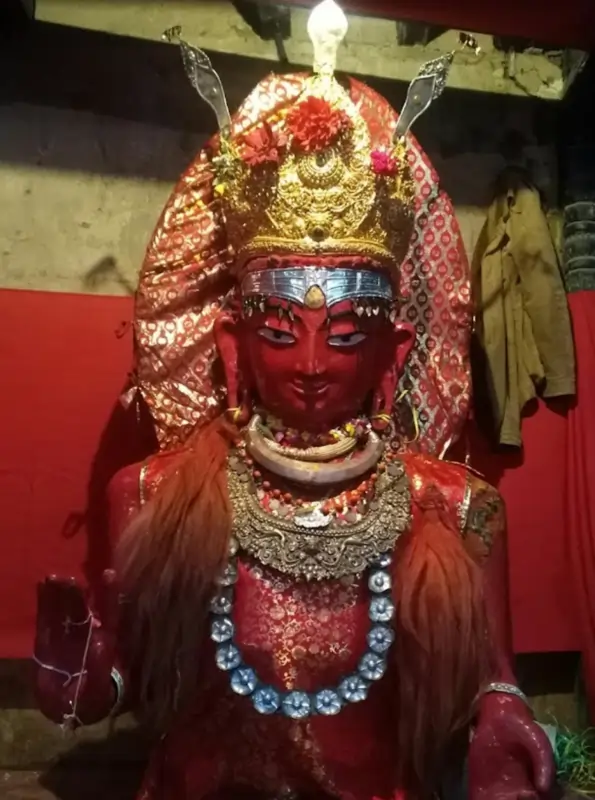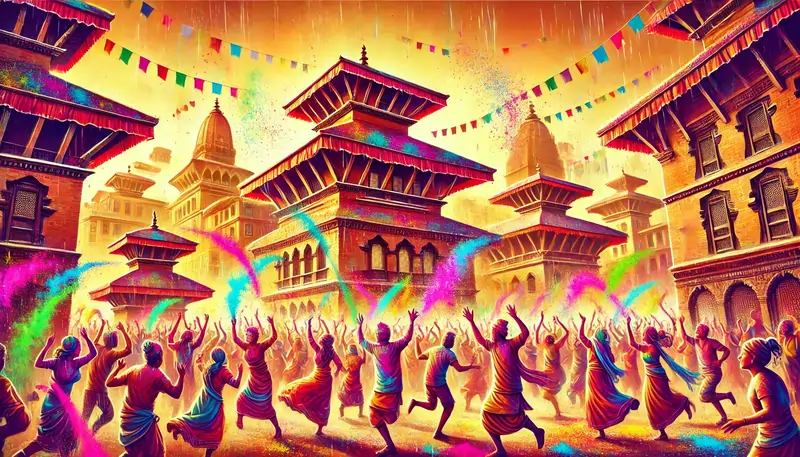The Many Faces of Holi
Holi Festival, in short Holi, in Newari language Holi Punhi, celebrated in the month of Fagun (March) on full moon day, is observed in various ways. Some celebrate it as Basantotsav (Spring Festival), while others associate it with the legend of Holika, who tried to burn Prahlad but perished in the fire instead. For some, Holi is seen as a festival of the lower classes due to its association with the use of obscene words and uninhibited revelry, while others emphasize its importance in Lord Krishna’s playful pastimes. These different perspectives and historical influences have given rise to various interpretations of Holi. However, considering the significance of spring and traditional folk songs sung during this time, it makes sense to celebrate Holi primarily as a festival of spring.
The Arrival of Spring and Its Impact
The changing seasons naturally affect all living beings, from plants to animals. The harsh winter strips trees of their leaves, leaving them bare and lifeless. However, with the arrival of spring, new buds emerge, and colorful flowers bloom. Similarly, birds that remained quiet due to the cold now sing melodious tunes, as male birds display their beauty to attract their mates.
Just as nature awakens, the human body also experiences renewed vigor with the arrival of spring. The season stimulates internal changes, increasing bodily fluids and, consequently, desires. Engaging in physical activities such as singing, dancing, and playing Holi helps balance these physiological changes. The festival, therefore, serves not only as a cultural event but also as a form of seasonal exercise.
Holi is traditionally celebrated in Fagun month from the eighth day (Ashtami) to the full moon (Purnima), which falls normally in March. It begins with the raising of the Chir, a ceremonial pole decorated with colorful cloth, which is burned on the final day, symbolizing the destruction of Holika. This tradition recalls the ancient story of Prahlad’s miraculous survival.
However, apart from the general customs of Holi, Kathmandu has a unique tradition associated with the festival, Chakan Dya’s city parade (jatra), which is of great significance.
Chakan Dya Jatra and the Legend of Singha Sartha Bahu
The Chakan Dya (चकंद्य:) Jatra begins at Bikramshil Mahavihar (see in map) in Thabahil, popularly known as Thamel, where Chakan Dya is worshiped as a deity. This idol, similar in form to Dipankar Buddha seen in Samyak and Panchadan festivals, has a red face and a distinct hand gesture. The tradition of worshiping Chakandya as a deity of movement (churning or traveling) is believed to be linked to Singha Sartha Bahu. According to legend, when Singha Sartha Bahu returned from Tibet after a successful trade expedition, the locals welcomed him with a Sindoor Jatra (vermillion festival), marking his safe return. This suggests the deep historical significance of the event.
The exact historical connection between Singha Sartha Bahu and Chakan Dya remains unclear. However, historical records show that traders, known as Singha Sartha Bahu in Sanskrit, traveled between Nepal and Tibet since the Licchavi period (circa 1,500 years ago). These traders played a crucial role in economic exchanges, sometimes facing severe hardships, including treacherous mountain crossings and encounters with thieves and wild animals. Returning safely was considered a great achievement, and their leaders were highly respected.
The Sindoor Jatra held on the day after Holi (Pratipada) is believed to honor these brave traders. Though no specific individual named Singha Sartha Bahu is worshiped today, the procession featuring a red-faced Bodhisattva-like deity reflects the memory of Nepalese traders who once traveled to Tibet. The timing of the festival aligns with the season when Himalayan crossings were most favorable (between Fagu and Baisakh), further reinforcing this connection.
Thus, the Sindoor Jatra not only highlights cultural traditions but also acknowledges the historical significance of Nepal’s trade relations with Tibet.

The Legend of Singha Sartha Bahu
Once, Singha Sartha Bahu led a group of traders to Tibet, where they made successful deals and gained great wealth. As they prepared to return home, many of his companions fell under the spell of Tibetan women and were unwilling to leave. Over time, Singha Sartha Bahu grew increasingly distressed by their entrapment and prayed for divine intervention.
That night, a compassionate deity appeared in his dream through the flame of an oil lamp and advised:
“Do not worry, Singha Sartha Bahu. You will return home safely with your companions. However, warn them never to look back while leaving, regardless of any temptations or emotional pleas from the Tibetan women. If they do, they will be devoured, for these women are actually demons.”
Encouraged by this divine message, Singha Sartha Bahu gathered his remaining companions and began their journey home. True to the prophecy, those who looked back were captured and killed, while he and a few others safely returned to Nepal.
Read Full Story on Singha Sartha Bahu – Chakan Dya >>>
The Mythology of Holika and Prahlad
The origins of Holi are also tied to the story of Prahlad and his father, the demon king Hiranyakashipu. Hiranyakashipu, blinded by his power, believed himself to be the strongest being in existence. However, his son Prahlad refused to worship him and remained devoted to Lord Vishnu. This led to a deep conflict between father and son.
Determined to kill Prahlad, Hiranyakashipu ordered his sister, Holika, who was immune to fire, to carry him into a blazing pyre. However, divine intervention saved Prahlad, while Holika burned to ashes. This event is believed to be the reason why Holi is celebrated with the burning of Chir, marking the triumph of good over evil. According to the Bhavishya Purana, Sage Narada once explained this story to Yudhishthira, emphasizing the festival’s spiritual significance.
Conclusion
Nepal celebrates numerous festivals, some of which are indigenous while others have been adopted from external influences. Though Holi may not have originated in Nepal, its joyful spirit and cultural adaptations, such as Sindoor Jatra and Chakan Dya (चकंद्य:) Jatra, have given it a distinct local identity. These traditions, deeply rooted in historical events and social customs, make Holi in Nepal not just a festival of colors but also an occasion to honor resilience, trade history, and the significance of physical and cultural celebrations.
References
- Nepali Chad-Parbaharu Ko Bibechana, Mana Bajra Bajracharya, 1968

